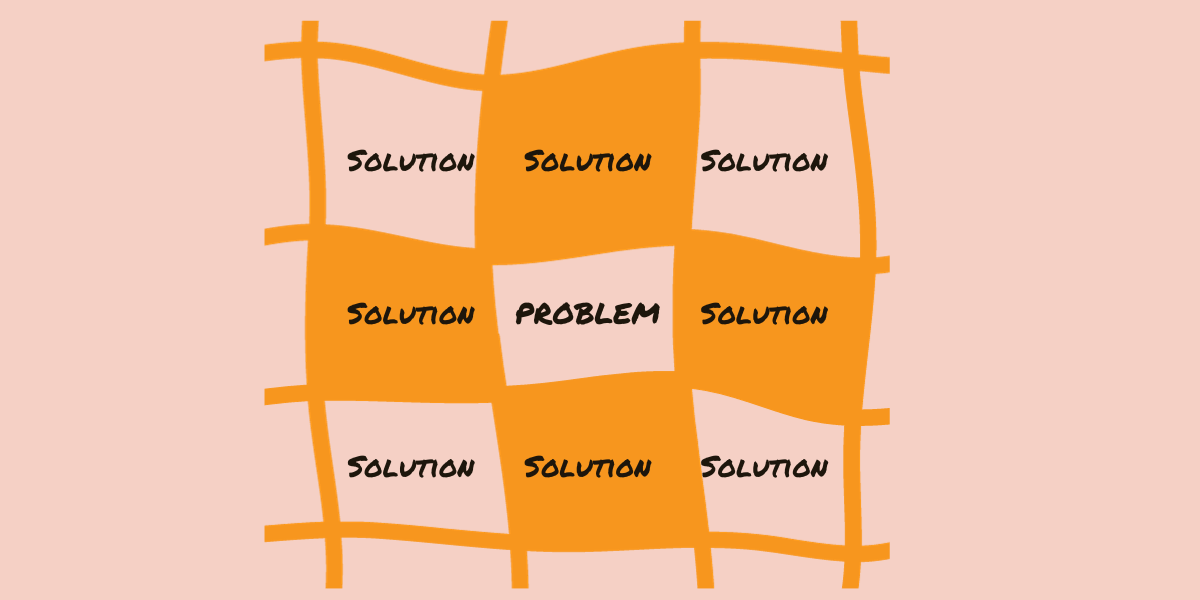When it comes to problem-solving and idea generation, the Lotus Blossom technique stands out as an easy and effective method (plus, it’s pretty fun). This approach, akin to a morphological chart, is a divergent form of brainstorming that encourages generating lots of different ideas. It’s particularly useful in the ideation phase of any project (for example, one using Design Thinking), where creativity and breadth of thought are crucial.
What is the Lotus Blossom Brainstorming Technique?
The Lotus Blossom technique is inspired by the multi-layered petals of its namesake flower. It involves a structured yet creative process that expands a central idea into various solutions and strategies.
Step-by-Step Guide to the Lotus Blossom Technique
- Start with a 9×9 grid: The process begins with a simple 9×9 grid, which can be drawn on a whiteboard or created digitally.
- Place the central problem: The core issue or problem is placed in the centre of this grid.
- Expand with solutions: Surrounding the central square, eight potential solutions are added, each in its own square.
- Create sub-grids for each solution: Each solution becomes the centre of its own 3×3 grid, allowing further expansion and exploration of your ideas.
- Adding layers of brainstorming: For each solution, additional layers of ideas, strategies, and tools are added to flesh out how each solution could be implemented.

Applying the Lotus Blossom in Practice
The method’s effectiveness is best understood through application. For instance, if you want to address a communication issue within your team, the central problem is placed at the grid’s heart. Surrounding solutions might include connecting to the team’s preferences, making communications more engaging, or seeking team member input. Each of these solutions is then further explored in their respective sub-grids.
For a personal reflection, such as new year’s goals, place the year 2024, in this case, in the centre square. Each area of your life you wish to interrogate (sleep, career, exercise, relationships) can then be added to the outside square and expanded upon. For example, I want to read more this year, which would become its own sub-square. I’d then start to fill out the squares with solutions, such as carving out time in my diary or buying a Kindle.
Tips for Effective Lotus Blossom Brainstorming
- The method works well both individually and in small groups.
- There’s no need to follow a linear path; feel free to jump between solutions.
- It’s an excellent tool for personal reflection and broadening perspectives on a problem.
Choosing and Combining Ideas
After filling out the grid, one can choose a single idea to pursue or combine multiple ideas for a more comprehensive approach. The beauty of the Lotus Blossom technique lies in its flexibility and the wealth of options it provides.
Adapting the Blosson to Different Environments
You can adapt the Lotus Blossom for both in-person and virtual settings. For in-person sessions, utilise whiteboards or flip charts (get out the markers!), while for virtual brainstorming, you can leverage tools like Jamboard, FigJam, or simple digital documents.
The Lotus Blossom brainstorming method is a powerful tool for generating diverse and innovative ideas. Whether you’re tackling a personal challenge or brainstorming for a team project, this method offers a structured yet flexible approach to expanding your creative horizons. Have you used the Lotus Blossom Technique? Let me know what you think!
If you enjoyed this article, subscribe to the Plein-Air newsletter for weekly posts on creativity, curiosity and working better.



